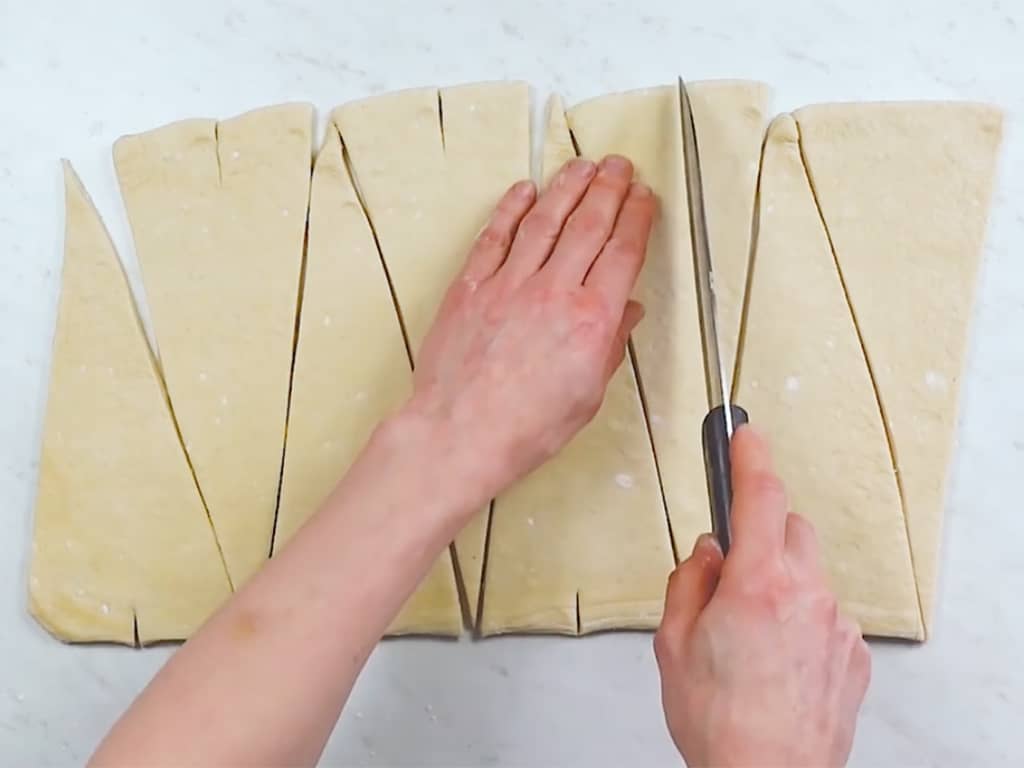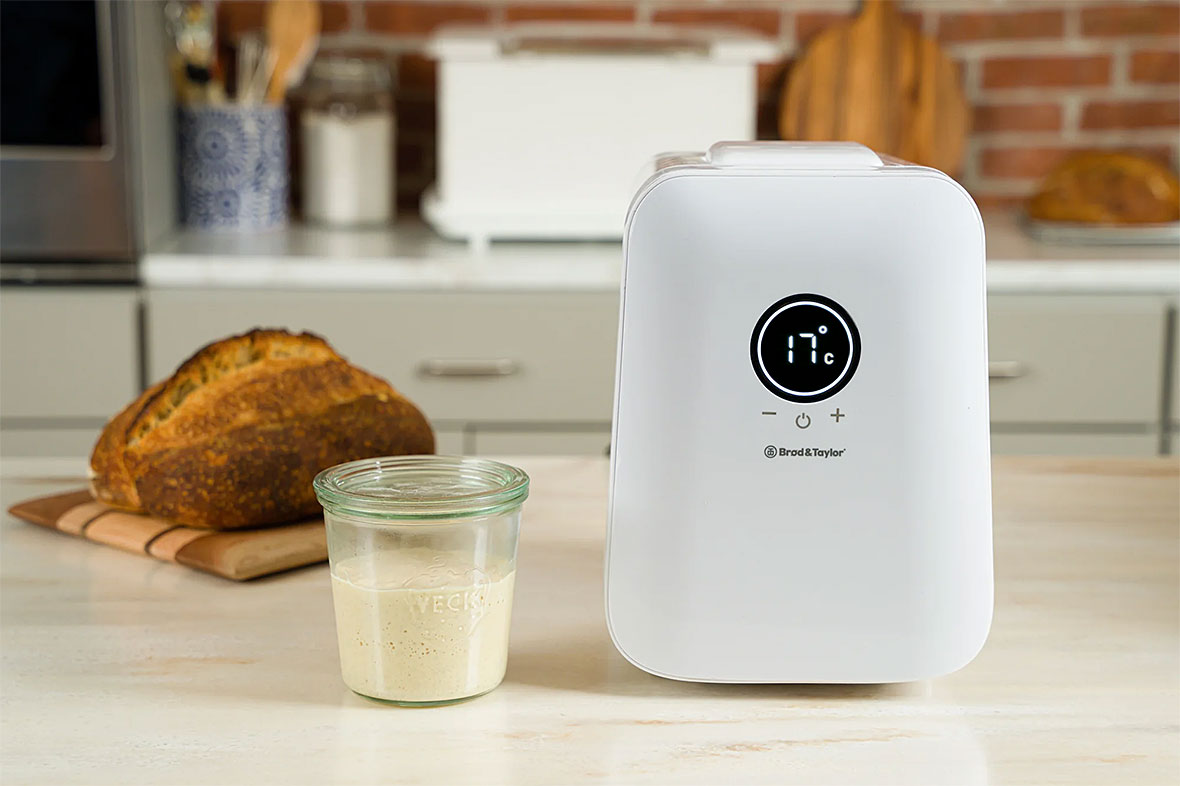Bread & Sourdough Recipes
Vegan Croissants
Vegan Croissants – Tasty and without butter!
Croissants are often wrongly accused of being too difficult to make at home and impossible to make without butter. Forget what you’ve heard! Making these savory, flaky pastries without butter is not only do-able, vegan croissants are just as delicious as their dairy-based counterparts.
How to Make Vegan Croissants
Homemade croissants, while a lengthy process, are a worthy endeavor. Croissants get their signature flaky layers through lamination, which is the process of repeatedly rolling and folding butter into the dough. Much of this process is inactive while the dough rests or proofs. While classic croissants are made with a high fat butter, our vegan croissant recipe calls for Miyoko’s Vegan Butter, which is a European-style butter made from cultured cashew milk that performs just as well as traditional butter.
It is important to pay close attention to the dough and butter as you are working. Maintaining the right consistency of dough and butter will allow for a better rolling experience and will produce the flakiest layers. The dough and butter should be as close in texture as possible so that they remain separate layers when rolling out, without the butter melting into the dough or breaking apart and pushing through the dough. This does not necessarily mean that the butter block and dough block will be the same temperature.
If at any point in the process the butter layer becomes too soft, take a pause and place the dough in the refrigerator for about 15 minutes. If at any point the butter seems too firm and breaks apart as it is rolled, leave it on the counter for a bit to soften the butter. If at any point the dough seems to resist rolling, allow it to rest (either at cool room temperature or in the refrigerator) for 15 minutes. Forcing the dough when it is resisting will damage the layers of butter and dough you are creating and result in a less flaky croissant.
Vegan Croissant Recipe
Yield
8 croissants
Timing
Active: 2 hours 30 minutes; Inactive: 19 ¼ – 44 hours; Total: 21 ¾ – 46 ½

Note: This timing can be altered to fit your schedule. After the final fold, the dough can be refrigerated overnight and the final steps can be completed the next day.
Ingredients for the dough:
- 400 g All-purpose flour*
- 8 g coarse salt
- 50 g granulated sugar
- 9 g Instant yeast
- 28 g vegan butter
- 112 g Soy milk (or other non dairy milk)
- 112 g Water
For the butter block:
- 200 g vegan butter
For the croissant wash:
- 42 g Soy milk
- 15 g Maple syrup or agave
Equipment
- Brod & Taylor High Capacity Baking Scale
- Mixing bowls
- Standing mixer (optional)
- Brod & Taylor Dough Whisk
- Plastic wrap
- Ruler
- Rolling pin
- Parchment paper
- Bench knife
- Pastry brush
- Knife/pastry wheel
- Brod & Taylor Folding Proofer
- Brod & Taylor Accessory Shelf
- 2 – 23 x 33 cm baking sheets
Instructions
Day 1
Mix the dough.
In the evening, add all of the dough ingredients to the bowl of a standing mixer. Use the dough whisk to begin incorporating the ingredients. Once you have a rough shaggy dough, attach the bowl to the mixer and mix on low speed for 4–5 minutes. The dough will come together but not be completely smooth and elastic. (The gluten will develop further through the rolling and folding that occurs in the lamination stage).
If mixing by hand, add all ingredients to a large bowl and use a dough whisk to begin incorporating the ingredients. Once the dough forms a rough shaggy mass, turn out onto the table and knead by hand for 5-7 minutes.
Press into a 15 x 20 cm rectangle (this will better prepare the dough to be rolled into a rectangle the next day) and wrap in plastic wrap. Place the dough block in the refrigerator overnight.
Day 2
Make the butter block.
In the morning, remove the vegan butter from the refrigerator. Either by hand or in the standing mixer, cream butter just to soften slightly and work out any lumps. Note: this step is not to incorporate air as if creaming for a cake, just makes the block more pliable. Place the butter on a piece of parchment paper and fold the paper over to encase it. Work the butter into a 13 x 18 cm rectangle, refolding the parchment as needed to make a smooth and even butter packet.
Roll out the dough, and lock in the butter.
Remove the dough from the refrigerator. The butter block should be pliable, not firm and cold. If the butter block seems too warm, it can be put in the refrigerator for a couple of minutes. If it seems too firm, it can sit out on the counter for a few minutes.
Roll the dough into a 20 x 33 cm rectangle. With the short edge of the dough facing you, place the butter block in the center of the dough block and fold the top and bottom sides together to meet in the center. Pinch the edges together if necessary.
Laminate the dough.
First fold
Turn the dough 90 degrees so the seam you just created is now running vertically. (During the lamination process, you should always be rolling in the direction of the open ends). With the rolling pin gently tap to flatten, moving down the length of the dough and then roll out to a 20 x 46 cm rectangle. Trim both of the 20 cm sides just enough (about an ⅛”) to create straight, even edges so the dough fits nicely together when folded.
Brush off excess flour from the surface of the dough. With the short edge facing you, take the bottom third of the dough and fold it toward the center. Brush off excess flour. Take the top third and fold it to the center on top of the fold just made. (This is just like folding a letter.) Gently roll over the folded dough with the rolling pin to seal the fold together so that it is back to a 15 x 20 cm rectangle.
You have now completed the first single fold. Wrap the dough in plastic wrap and place in the refrigerator to rest for 30 minutes.
Second fold
Unwrap the dough from the plastic wrap, turn the dough 90 degrees from the direction it was last rolled in, and roll out to a 20 x 46 cm rectangle, following the same steps as the first fold to complete the second fold. If there is one side that has uneven seams, make that the side you fold in on itself. Wrap dough in plastic wrap and rest in the refrigerator for 1 hour.
Third and final fold
Remove from the refrigerator and repeat the rotating, rolling, and folding process one more time. Wrap the dough and place in the refrigerator to rest for anywhere from 3–24 hours.
Roll and cut the dough.
Roll the dough to a 48 x 27 cm rectangle. If the dough is resisting at any point or shrinks back after rolling, let it rest for 15 minutes before continuing with rolling. Trim the long edges of the dough so it measures 48 x 25 cm. Brush off any excess flour. Starting at the bottom left side of the dough, make a small score mark every 10 cm.
Along the top long edge of the dough, measure 5 cm in from the left side. Starting at this point, make a small score mark every 10 cm along the dough. Using a pastry wheel or knife, cut diagonal lines connecting the score marks made, creating eight triangles. Place the pieces on a sheet pan, wrap with plastic wrap, and place in the refrigerator for 15 minutes.
While the pieces are resting, clean any excess flour off of the work space and line two small 23 x 33 cm baking sheets with parchment paper.

Shape the croissants.
Turn the Folding Proofer on, fill the water tray, and set to 24 °C. Preheat for 10–15 minutes as you shape your croissants. Remove the cut triangles from the refrigerator.(Optional: Cut a small 2 cm slit directly in the center of the base of each triangle to help elongate the base and allow for a more open center crumb). With the base of the triangle held in one hand, elongate the dough by gently stretching from the base and continue all the way to the tip of the triangle. Starting at the base of the triangle, roll the dough up toward the tip—trying not to roll too tightly as you go. Repeat until all triangles are rolled.
Place the rolled croissant on the prepared sheet pan. Make sure the tip of the rolled croissant stays tucked under as it is placed on the pan. When done, you should have four croissants per sheet pan.
Proof the croissants.
Place one sheet of the croissants in the Proofer, place the accessory shelf in the Proofer, and then place the other sheet pan of the croissants on the shelf. Secure the Proofer lid. Let croissants rise for 2.5–4 hours, until the croissants have noticeably increased in size, appear light and poofy, and wobble when the pan is gently shaken.
Check the water tray periodically and refill if needed. If at any point the croissants seem dry, cover with plastic to prevent a skin from forming or very lightly mist with water from a spray bottle.
Do not raise the temperature in an attempt to speed up the process. If the temperature is too warm the butter will begin to melt, affecting the lamination of the dough.
Bake the croissants.
When the croissants are almost done proofing, preheat the oven to 204 °C.
Remove the croissants from the Proofer. In a small bowl, mix the soy milk and syrup. Gently brush the croissants with the wash. Bake the croissants for 10 minutes. Turn the oven down to 190°C and bake for another 12–15 minutes. Remove the croissants from the oven and allow them to cool completely.
Croissants are best eaten the day they are baked. That said, they will still be good for a couple of days after baking. Store in an airtight container at room temperature and reheat at 175 °C for 8–10 minutes.




 Select Country
Select Country











